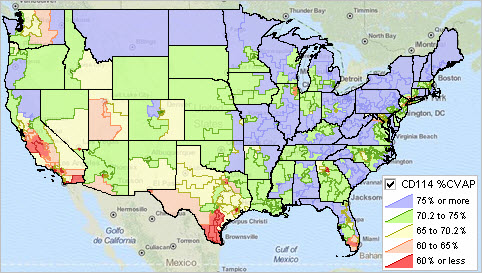

|
|
|
114th Congressional District Citizen Voting Age Population -- examining voting age population by 114th congressional district
Percent Citizen Voting Age Population by 114th Congressional District  - view developed with ProximityOne CV XE GIS and related GIS project. Examining patterns of the citizen voting age population ... the Voting Rights Act prohibits development of voting districts that discriminate against potential voters on the basis of race and/or language minority status. To examine how voting districts comply with the Voting Rights Act requires data on the citizen voting age population (CVAP) by race/origin for many types of geographic areas. This section provides data analytics tools to examine ACS 2014 1-year CVAP estimates for 114th Congressional Districts. See related section for information CVAP demographics at the census tract level. The CVAP data can be used to develop insights into alternative interpretations of "one person one vote." The Supreme Court on May 26, 2015, agreed to hear a case that will answer a long-contested question about a principle of the American political system -- the meaning of "one person one vote." The court has never resolved whether that means that voting districts should have the same number of people, or the same number of eligible voters. The difference matters in places with large numbers of people who cannot vote legally, including immigrants who are here legally but are not citizens; unauthorized immigrants; children; and prisoners. The CVAP estimates provide only one part of the required data. Voting district and other boundaries and data are also needed to be used in combination with the CVAP estimates. Using GIS tools, the CVAP estimates can be used in mapping applications, such as those reviewed in this section, in combination with voting district boundaries to reveal potential non-compliance in the structure of voting districts. Use the interactive table in this section to view/rank/compare/query national scope citizen and CVAP estimates by 114th Congressional District, state and the U.S. These data are based on ACS 2014 1-year estimates found in Table B05003. These data are also available for several race origin categories (not shown here). Column 8 (CVAP) in the table is the citizen voting age population estimate and is derived by summing items B05003_004, B05003_006, B05003_009, B05003_011. 114th Congressional District Citizen Voting Age Population - Interactive Table Click ShowAll button between Find/Queries. Use mouseover on column header to view column description. See usage notes below ranking table. See related ranking tables -- http://proximityone.com/rankingtables.htm. Usage Notes • All items are estimates as of 2014. • Cells with -1 value could not be estimated (for this geography and this time frame). Determining Congressional District Based on Address Key in an address here to find codes/names to determine congressional district, city/place, school district, census tract, etc. geocode/area name based on address. Key in an address here to view demographic-economic characteristics (and associated geographic codes) for that location (.e.g., for corresponding block group, census tract or other area containing that address). ACS 2014 1-year Table B05003 Items -- Gender by Age by Nativity and Citizenship Status; Universe: Total population
Support Using these Resources Learn more about demographic economic data and related analytical tools. Join us in a Data Analytics Lab session. There is no fee for these Web sessions. Each informal session is focused on a specific topic. The open structure also provides for Q&A and discussion of application issues of interest to participants. ProximityOne User Group Join the ProximityOne User Group to keep up-to-date with new developments relating to geographic-demographic-economic decision-making information resources. Receive updates and access to tools and resources available only to members. Use this form to join the User Group. Additional Information ProximityOne develops geographic-demographic-economic data and analytical tools and helps organizations knit together and use diverse data in a decision-making and analytical framework. We develop custom demographic/economic estimates and projections, develop geographic and geocoded address files, and assist with impact and geospatial analyses. Wide-ranging organizations use our software, data and methodologies to analyze their own data integrated with other data. Follow ProximityOne on Twitter at www.twitter.com/proximityone. Contact ProximityOne (888-364-7656) with questions about data covered in this section or to discuss custom estimates, projections or analyses for your areas of interest. |
|
|